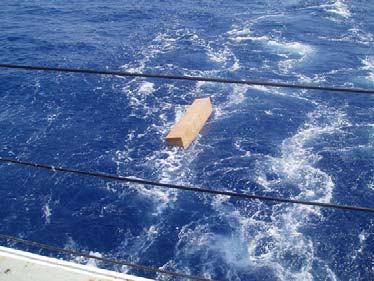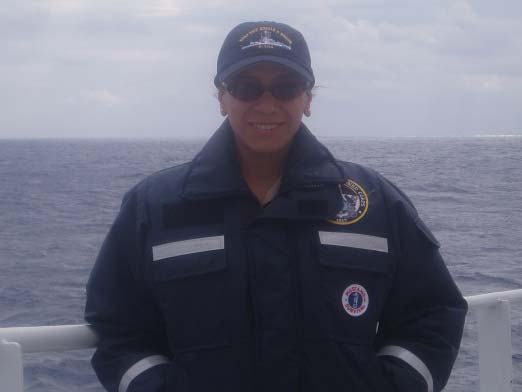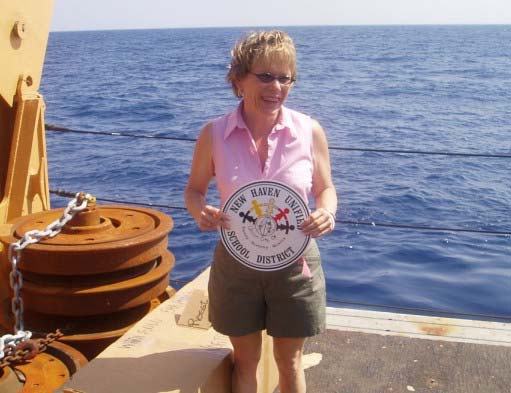NOAA Teacher at Sea
Vince Rosato & Kim Pratt
Onboard NOAA Ship Ronald H. Brown
March 9 – 28, 2006
Mission: Collect oceanographic and climate modeling data
Geographical Area: Barbados, West Indies
Date: March 24, 2006
Science and Technology Log
SHIP VOCABULARY
The meaning of common ship terms may help land “lubbers,” (people who love life off the sea), get around this home on the seas. First, let’s cover directions on a ship. The front is called the BOW and the back end is called the STERN. The very back deck over the propellers is the FANTAIL. Facing the bow, the right side is the STARBOARD SIDE and the left side is the PORT SIDE. The KEEL is under the middle of the boat. The WATERLINE is where the water meets the HULL on the outside of the ship. The picture today is of the interior, or inside of the ship. Use the picture diagram to practice your knowledge of shipboard terms.

A cross sectional view of the RONALD H. BROWN.
The floor of the ship is called the DECK. Stairs to the eight different levels are called LADDERS. The ceiling is called the OVERHEAD and the hallway is called the PASSAGEWAY. When seas are choppy, you hang onto RAILINGS along the passageway and ladders. Railings can keep you from falling. There is a safety phrase aboard that goes, “One hand for you and one hand for the ship.” That means it’s safer to always touch some part of the ship.
Let’s go down where food and supplies are STOWED or put away before being brought up to cook and eat. In the HOLD AND TANK TOP, two decks below the MAIN DECK you find the ship’s STORES, or storage area. There are dry stores, a chill box, a freeze box, a room for cleaning supplies, and another for ship’s supplies, including shelves of flags. That’s five different rooms for food or supplies on this bottom floor, the HOLD. The temperature in the CHILL BOX keeps fruits and vegetables just above freezing, but the FREEZE BOX feels like being turned into instant ice. Those two lockers have safety latches so you can’t get locked inside. Together they measure about 11 feet wide by 12 feet long by 8 feet high, the size of a medium size moving van.
The DRY STORES keep all the extra cereal, tea and dry foods that do not need to be chilled. It is bigger than the freezer locker, about 110 square feet, the size of a small garden shed. It has over 60 shelves, each 2 feet by 4 feet by 2 feet, the size of a garment or hanging clothes type-moving box. Michael Moats, the General Vessel Assistant, pointed out the SOPROLE, a milk product substitute that doesn’t need chilling for a long time. A phone and an elevator are handy outside the supply rooms. The kitchen areas, “the Galley,” and dining room, “the Mess Deck,” are two ladders up, so the elevator and phone make checking on and moving supplies easier. There is also a HEAD, or toilet, on the MESS DECK. The chief steward, Richard Whitehead, mentioned that in the GALLEY the safety bars on the ship’s stoves are called SEA RAILS. A great reference for these and many other ship terms and the flag alphabet is http://www.schoonerman.com/sailingterms/. Time for more ship term practice!
The RONALD H. BROWN is 274 feet long and sails worldwide supporting our scientific understanding of the world’s oceans and climate. The ship was commissioned, at a big birthday-like celebration, on July 19, 1997, in honor of the late Secretary of Commerce, Ronald H. Brown. To commission a ship is to put it into service at sea. The ship carries six NOAA Corps officers, 20 crewmembers, and a maximum of 33 scientists. The ship has two monster motors that give power to the ship. Each one has the power of 3,000 horses pulling a load, or 3,000 hp. Top speed is 15 knots or fifteen nautical miles per hour. That’s a little faster than a car going 17 miles per hour, mph. The ship makes 5,000 gallons of drinkable water a day just like the rain purifies water, by evaporation and condensation. We use about 4,000 gallons a day here. Since we can only make water thirteen miles away from shore we need to not waste our water supply.
Interview with Commander Stacy Birk, Executive Officer
Commander Stacy Birk said, “It’s a tough life at sea,” so she really tries to make life on the RONALD H. BROWN valuable and meaningful for all hands. Stacy is the Executive Officer, XO. As the captain’s back up, the XO is boss in the captain’s absence. She manages people, deals with people’s salaries and serves as safety officer while the ship sails from Charleston, SC, for about ten months of the year. In elementary school Stacy enjoyed the books Island of the Blue Dolphins and I, Nathaniel Bowditch. This California surfer girl completed college and joined the Coast Guard Reserves. She actually sailed around the Channel Islands.
As a personnel manager, Stacy hires people and evaluates them, like a teacher gives grades. As a safety officer, the XO helps people follow the rules, such as not wearing open toe shoes or not leaving kitchen cups around the ship or showing up at the wrong place for drills. You might compare this to a parent making sure rules are followed. She does everything possible to be fair with people. Stacy’s science background and sailing experience help her make accurate observations. Her uniformed service as a NOAA Corps Officer and her rank as XO fit with her respect of the sea from childhood. Not everyone has such a clear direction from youth. She just celebrated her 19th wedding anniversary and suggested to students, “Visit ships in port in San Francisco, explore the TECH museums or practice flag signals,” to grow in ocean knowledge.

XO, Stacy Birk, during the Port Authority passport-clearing trip at Marsh Harbor, Abaco Island, Bahamas
Assignment and question of the day: Use as many of the ship terms in place of the land names. Example: Instead of saying, “I’m walking down the hall,” say “I’m walking down the passageway.” BONUS: Check out that website to learn more ship terms. What is the perimeter of the CHILL BOX and FREEZE BOX together? Hint: Check the length and width of both boxes.
Personal Log – Vince Rosato
After a great night’s sleep I learned at breakfast that a small shark was sighted during the night as the CTD was at the surface. I also found out about an awesome website, http://www.ngsednet.org/oceans, that has pictures taken by students from my previous expedition to the Channel Islands with National Geographic. You will see more critters on that site, for those interested. In addition, over 7,000 living organisms will be under investigation on the RONALD H. BROWN’s next cruise. I took a tour of engineering today, thanks to Chief Engineer Frank Dunlap. The engineering department powers and maintains all systems on the ship; something like the Corps Yard does for our District. Juliet, the flat person, took some pictures with two of our Southampton college graduates and with a few of the people on Stuart Cunningham’s Mooring Team. Keep up your journal entries and emails.
Personal Log – Kimberly Pratt
Hi all. Last night I saw two Mahi Mahi fish, which they also call dolphins or dolphinfish. They were swimming along side of the ship and at first I thought they were sharks! They certainly are beautiful. Yesterday the scientists from the United Kingdom worked on moorings all day so I got some time off. Today we’re busy again doing CTD casts and my job lately has been “cast cop”, which means I log all the data. The weather continues to be nice, although today we went through a squall (which is a storm) and now it’s overcast outside. Also today we received a distress call from a Catamaran that was taking on water, so we proceeded to go to help, but the Coast Guard was on their way and they also called a tow service from a nearby island to help them. It sure added some excitement into our day! With less than a week to go, things have certainly been busy!



























